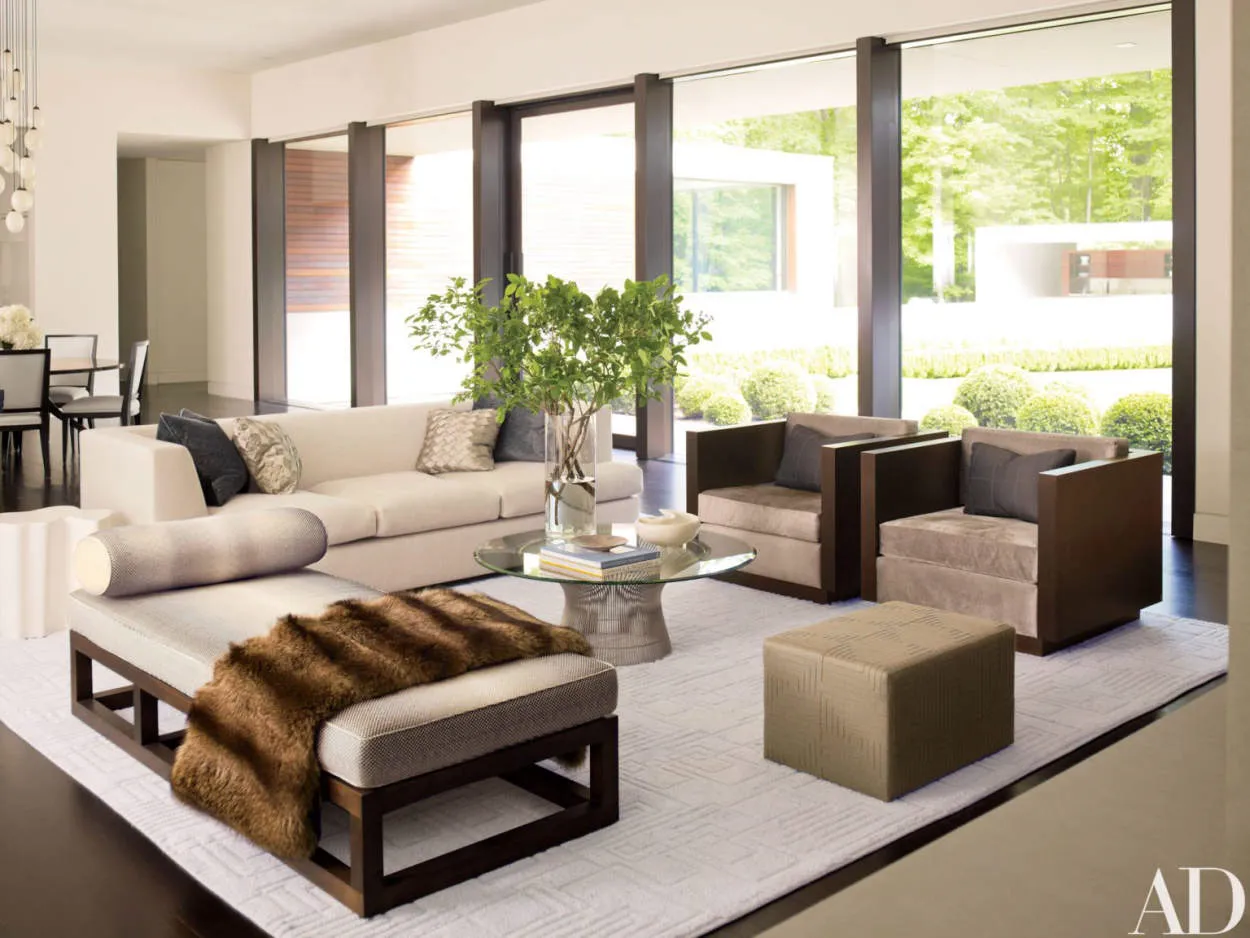The Balanced Living Room: Symmetry in Design
Achieving Symmetrical Balance
In the world of interior design, achieving balance is a fundamental principle that can elevate the overall look and feel of a room. One popular approach to creating balance is through symmetrical design.
Symmetry involves arranging elements in a space in a way that creates a mirror image. This can be accomplished by placing identical objects or furniture on either side of a central axis. For instance, a pair of identical armchairs or matching table lamps can be positioned on opposite sides of a sofa to achieve symmetrical balance.
The use of symmetry not only brings harmony and order to a room but also creates a sense of visual stability. It provides a sense of equilibrium that is pleasing to the eye and promotes a calming atmosphere.
When implementing symmetrical balance, it is essential to consider the overall scale and proportion of the elements used. Placing equally sized items on each side of the central axis ensures a balanced distribution of visual weight.
Besides furniture arrangements, symmetrical balance can be enhanced through other design elements such as artwork, windows, and architectural features. Hanging a pair of identical artworks or placing two identical windows on opposite sides of a room can further enhance the symmetrical aesthetic.
While symmetrical design can create a formal and traditional look, it can also be adapted to suit various styles and preferences. By incorporating asymmetrical elements or adding a touch of uniqueness to the symmetrical arrangement, one can achieve a balanced living room that is both visually appealing and personal.
Furniture Arrangement Techniques
In creating a balanced living room, one effective technique to consider is symmetry in design. Symmetry brings a sense of order and harmony to a space, making it visually appealing and comfortable. Here are a few furniture arrangement techniques to achieve symmetry in your living room:
1. Centered Furniture Placement
Start by placing your larger furniture pieces, such as sofas or sectionals, in a central position within the room. This creates a focal point and establishes a sense of balance. Arrange other furniture items, like armchairs or coffee tables, around this central piece.
2. Mirror Imaging
To achieve symmetrical balance, mirror the arrangement of furniture on one side of the room to the other side. For example, if you have a sofa on one side, place a matching sofa or a pair of armchairs on the opposite side. This creates a visually pleasing and cohesive look.
3. Balance with Accessories
In addition to furniture, incorporate accessories to enhance the symmetry. Use pairs of identical or similar items like table lamps, decorative pillows, or wall art on each side of the room. This further enhances the sense of balance and equilibrium.
4. Pay Attention to Scale
Consider the scale of your furniture pieces when arranging them symmetrically. It’s important to ensure that the sizes and shapes of the items are balanced and proportional to each other and to the room. This prevents one side from appearing heavier or overpowering the other.
By employing these furniture arrangement techniques, you can create a balanced living room that exudes a sense of symmetry in design. Experiment with different layouts and placements until you achieve the desired visual equilibrium and an inviting space for relaxation and entertainment.
Decorative Pairings
In the world of interior design, achieving balance is crucial for creating a harmonious living space. One effective way to bring balance to your living room is through the use of symmetry. By incorporating decorative pairings, you can create a visually appealing and balanced atmosphere.
1. Matching Furniture
Start by selecting a pair of matching furniture pieces, such as two identical armchairs or side tables. Placing them on opposite sides of the room instantly creates a sense of symmetry.
2. Mirror, Mirror
Hanging a pair of mirrors on a wall across from each other not only adds depth to the room but also creates a mirror image effect. This simple trick can make your living room appear larger and more balanced.
3. Balanced Colors
Choose a color scheme that balances each other. For example, if you have a bright orange sofa, consider pairing it with a neutral-toned rug and curtains. This way, the colors can complement each other without overpowering the room.
4. Symmetrical Wall Art
Hang artwork or photo frames in pairs with equal spacing between them. This symmetrical arrangement adds a sense of order and balance to the room.
5. Twin Lighting
Place a pair of identical lamps on either side of a console table or fireplace. This not only provides balanced lighting but also creates a cohesive look.
6. Pattern Play
Introduce patterns in pairs, such as a pair of matching throw pillows or a set of coordinated curtains. This repetition of patterns brings a sense of unity and symmetry to the living room.
7. Natural Elements
Incorporate natural elements such as a pair of potted plants or matching vases filled with fresh flowers. These elements not only bring life to the space but also add a touch of symmetry.
By incorporating these decorative pairings, you can create a balanced living room that is visually pleasing and inviting. Embrace symmetry in your design and transform your living space into a harmonious haven.
Art and Accessory Placement
In a well-designed living room, art and accessories play a crucial role in creating a harmonious and balanced space. When it comes to arranging art and accessories, symmetry can be a powerful design tool to achieve a cohesive look.
One effective way to incorporate symmetry is by using pairs of identical or similar art pieces and placing them symmetrically on the walls. This creates a sense of balance and visually anchors the room. Additionally, wall shelves can be used to showcase smaller art pieces or decorative objects symmetrically.
Another aspect to consider is the placement of accessories on furniture. By placing similar accessories, such as vases or candle holders, on either side of a mantel or console table, symmetry is achieved. This creates a visually pleasing focal point and adds a touch of elegance to the room.
When arranging furniture, symmetry can also be applied. Placing identical armchairs opposite each other or positioning a pair of matching side tables on either side of a sofa brings a sense of order and balance to the living room.
While symmetry is a valuable design principle, it is important to also consider contrast and variation. By combining symmetrical arrangements with asymmetrical elements, such as different sizes or shapes, a dynamic and visually interesting space can be achieved. This adds depth and personality to the overall design.
In conclusion, when it comes to creating a balanced living room, art and accessory placement play a significant role. By utilizing symmetry as a design tool, a sense of order and harmony can be achieved. However, it is essential to strike a balance between symmetry and variation to create a visually appealing and inviting space.
Color Symmetry
In the world of interior design, symmetry plays a significant role in creating a balanced living room. One of the key elements in achieving symmetry is the use of color. When applied correctly, color symmetry can bring harmony and visual appeal to any space.
The Power of Color
Colors have a profound impact on our emotions and can greatly influence the overall atmosphere of a room. By incorporating a coherent color scheme, you can establish a sense of balance and order in your living room.
Choosing the Right Colors
When aiming for color symmetry, it is essential to select colors that complement each other. Opt for a main color or palette that resonates with your desired ambiance. Utilize the color wheel to identify complementary or analogous hues that will enhance the symmetry in your room.
Balancing the Palette
Ensure an even distribution of colors throughout your space. You can achieve this by incorporating matching or coordinating accents on both sides of the room. Whether it’s through pillows, artwork, or other decorative elements, maintaining a symmetrical distribution of color will improve the overall visual equilibrium.
Contrasting with Neutrals
Neutral colors such as white, beige, or gray can act as a visual anchor, allowing your chosen colors to stand out and create a harmonious balance. Use neutrals as a backdrop to highlight the symmetry and prevent the space from appearing too overwhelming.
Attention to Detail
Don’t forget about the smaller details in your living room. Consider incorporating color symmetry in curtains, rugs, furniture, and even lighting fixtures. Attention to these details will further enhance the overall sense of balance and cohesiveness in your space.
Final Thoughts
By incorporating color symmetry into your living room design, you can create a visually appealing and balanced space. Remember to choose colors that complement each other, balance the color palette, and pay attention to the smaller details. With color symmetry, you can transform your living room into a harmonious haven.
Conclusion
In conclusion, incorporating symmetry in the design of a living room creates a balanced and harmonious space. By placing furniture, accessories, and artwork in a symmetrical arrangement, it creates a sense of order and elegance. Symmetry also helps in achieving a visually pleasing and cohesive look, making the living room a welcoming and inviting place for relaxation and entertainment.




